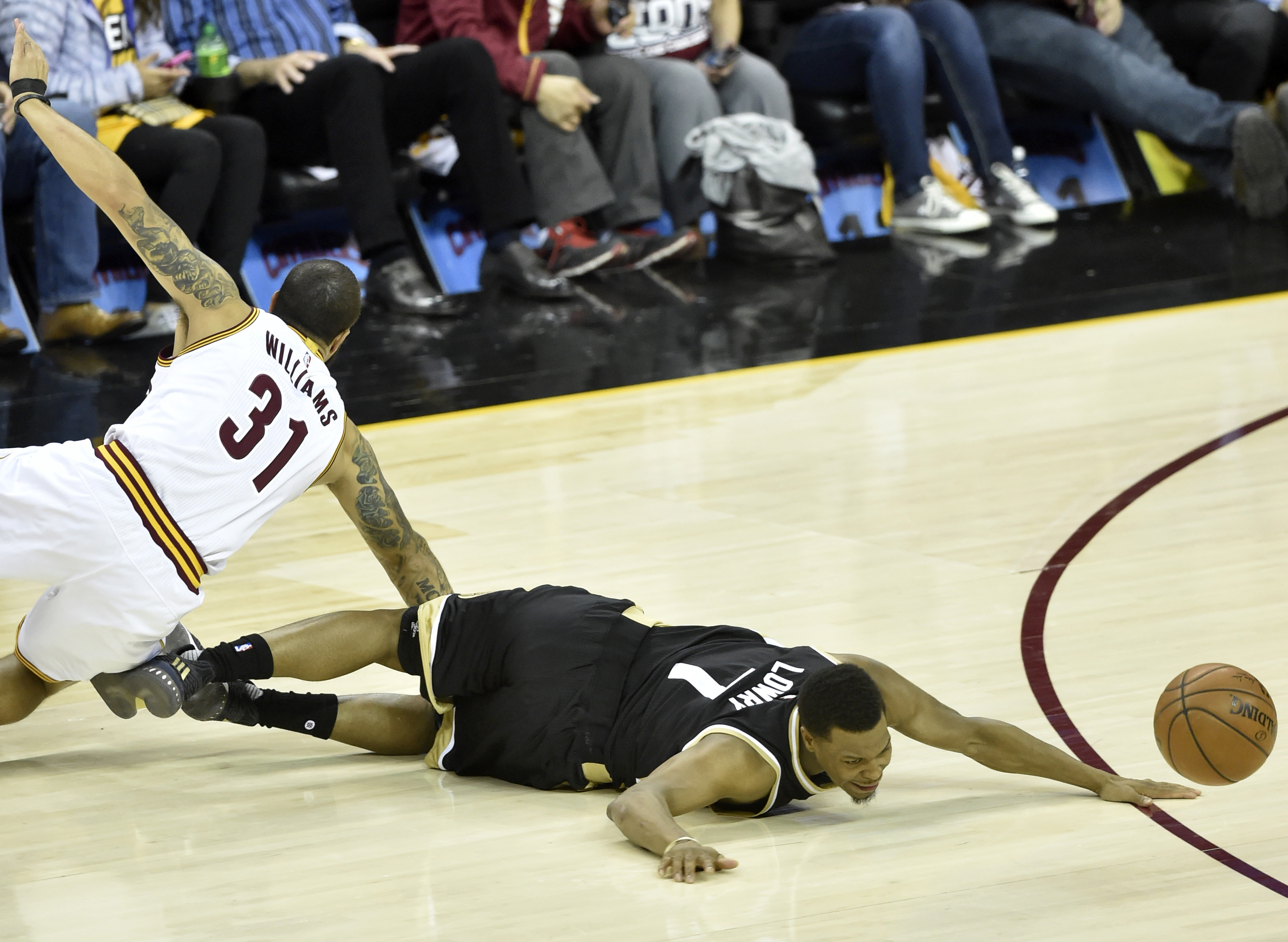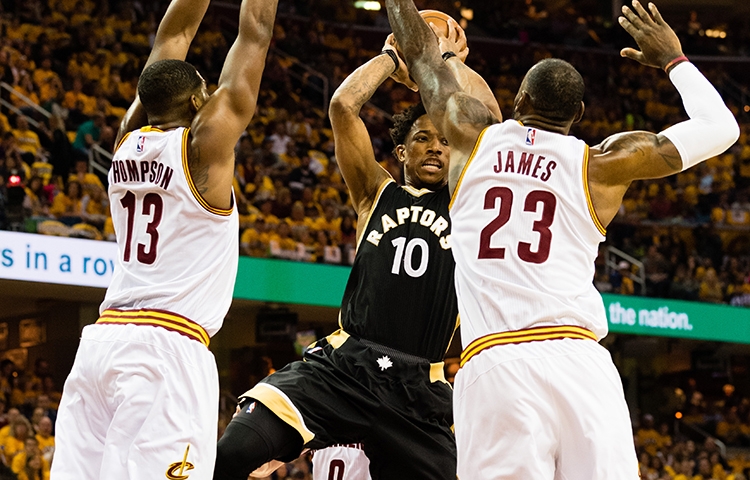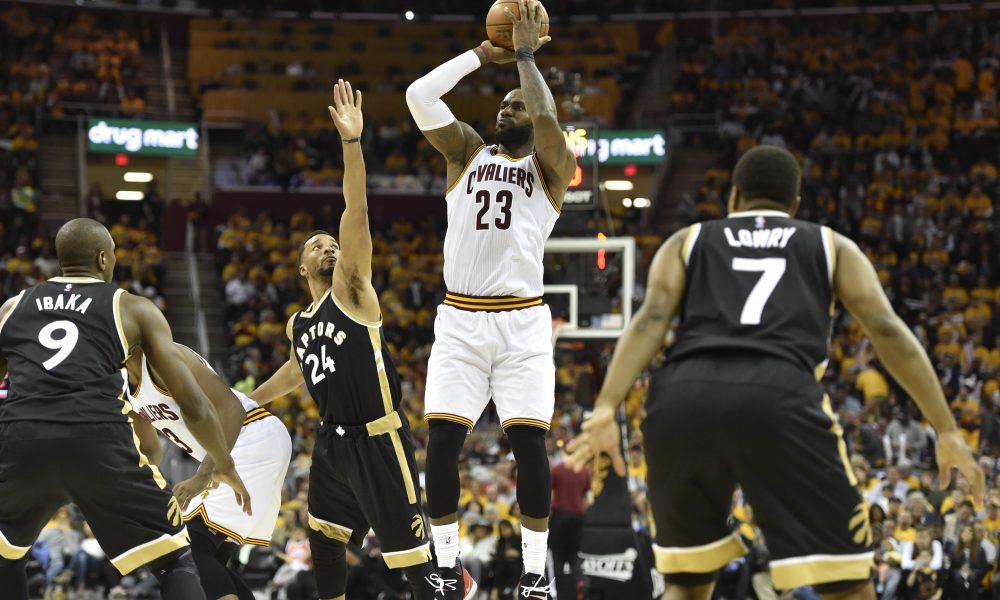Raptors 103, Cavaliers 125 (Cavaliers lead series 2-0) | Box Score | Quick Reaction | Post-game news & notes | Reaction Podcast
The Toronto Raptors took the opening Game 1 punch against the Cleveland Cavaliers, because that’s what the Raptors do and, really, it’s what they were supposed to do in a series like this, playing the role of underdog against the team perceived to be the inevitable Eastern Conference representative in the NBA Finals. In the process of doing so, they learned some lessons, largely what didn’t work, because there was little that actually did work. When you lose, don’t lose the lesson, and all that. There’s no choice but to treat an opening salvo like that and hope it informs some improvement the rest of the way.
With time to regroup, head coach Dwane Casey made the decision to change his starting lineup. It was a necessary move, as the Raptors have continually started slow with the starters they used in Game 1, and the margin for error here is too small to go with a known negative. The solution to the problem, though, was not as obvious as the existence of the problem itself. He opted to remove DeMarre Carroll and Jonas Valanciunas from that group in favor of Norman Powell and Patrick Patterson, hoping additional speed and switchability and spacing would cure what ailed them. On paper, it was a reasonable move. Several would have been. Something had to change.
Nothing did, though.
The Cavaliers sent the message pretty early that no matter the changes the Raptors made and no matter the level they brought their defense to, it wasn’t going to matter much. Toronto’s defending of the 3-point line was noticeably improved early on, particularly in terms of limiting attempts. With a couple of exceptions, most of the Cavaliers early looks from long range were of the contested variety. It didn’t matter – Cleveland somehow hit their first eight 3-point attempts, a mark Steph Curry would struggle to maintain in an empty gym, with several drawing what-can-you-do shrugs. When LeBron James is spinning the ball in his hands for fun and hitting a triple with a hand in his face, or Kyrie Irving is falling on the baseline hoisting a two, or Iman Shumpert if flailing out of control and finding the bottom of the net, there’s only so much a defense can do.
“I thought a lot of them, we were in their faces,” Casey said. “They’re shooting the ball very well. We’ve got to make them miss, but a lot of those, we’re in their grill, hand up, and they’re making some tough shots. We can do better, we can get closer.”
The issue with the 3-point barrage, and Cleveland’s offensive power in general, is that it makes pulling away an easy task for them and feels like it comes out of nowhere for an opponent. Despite the early shooting, Toronto kept the game relatively close through the first half, at least by the standards of how these meetings normally go in Cleveland. The Cavaliers never led by more than 15, and the Raptors were withing single digits with 98 seconds to play in the second quarter. This is damning with feint praise, but the formula for the Raptors is to keep things as close as they can. They’re not going to run away with, or even control games.
A big part of keeping it close was how Valanciunas once again responded to coming off of the bench. After Serge Ibalka struggled with decision-making and his shot out of the short-roll and had trouble with Cleveland tagging him on the dive, Valanciunas slid into those same actions more seamlessly. Some of it was the Cavaliers accepting Valanciunas doing work – they’d likewise accept it if Ibaka got cooking if it meant the ball was out of the hands of Toronto’s stars – and part of it was soft hands and great assertiveness from Valanciunas. He shot 9-of-10 in the half, scoring 19 points in 13 minutes, and even with only one rebound on his ledger at that point, he helped Toronto keep up as Cleveland continued raining hell-fire. Channing Frye posed a problem, yes, but Valanciunas punished him the other way, too (Frye continued to be a problem later, though). It’s a tough trade-off, one the Cavaliers let Toronto try to exploit, but Valanciunas deserves credit for his response regardless.
And still, the Cavs pulled away. Those final 98 seconds saw them push the lead to 14 at the half, and a pair of missed free throws for DeMar DeRozan capped a disaster of a start to the game for him. The Milwaukee Bucks presented more difficult, aggressive traps and DeRozan responded well, but Cleveland’s approach has frustrated him so far, and DeRozan shot 0-of-7 through two quarters and 1-of-3 at the free-throw line, with just one assist. Kyle Lowry was better, scoring 15 with four assists by the break and attacking the paint more than anyone else seemed willing, but the general passiveness of the Raptors’ approach earned them their limited seven free-throw attempts (the Cavs would heavily out-shoot them at the free-throw line, but that gap felt largely deserved).
Really, though, there’s not a lot to be done about a 10-of-15 mark on threes in a half, and it’s perfectly ironic that Cleveland only started to miss as Toronto did a worse job limiting their attempts (regression, sure, but ironic all the same). Even with Kyrie Irving shooting 2-of-11 overall, Cleveland had no trouble ringing up 123.6 points per-100 possessions for a 62-48 halftime lead.
The second half somehow started out even worse, with a quick injury scare as Powell landed on the left leg of Lowry going for a defensive rebound. Lowry returned quickly and tried to assert his will on the game while hobbled, and the Raptors’ offense actually responded pretty well, scoring 17 points in the opening half of the third quarter. Yet somehow, Cleveland’s lead swelled to 20, with some shaky pick-and-roll defense and a return to torrid shooting for the Cavaliers rendered Toronto’s defense punchless. DeRozan continued to struggle in a major way (non-DeRozan Raptors shot 51.7 percent through three quarters), and while he didn’t get a ton of support in making life a little easier on him, they needed a lot more out of him. Valanciuans’ early re-entry also didn’t tilt the way it had in the first half because the Raptors asked him to hedge and trap outside of his skill set, Casey gave DeRozan an early breather, and none of the straws Toronto grasped for worked out.
“We talk about it over and over and over again, but we just don’t do it,” Valanciunas said of the defensive slide.
Shooting threes would help. Whatever thoughts on the defensive execution or free-throw gap or whatever, shooting just 17 triples in a modern NBA playoff game, against the league’s second-most prolific 3-point shooting team, is death. Toronto even hit one more total field goal in the game, but they were outscored by 39 from beyond the arc. You can’t change who you are, but sometimes who you are isn’t good enough.
Just to make sure the Raptors knew they were to stay down, Irving dropped a beautiful pass to James in transition for a massive dunk. That was the call for the white flag, as the team gave Lowry the hook to rest his ailing ankle from there and watched the lead balloon to 26 at the end of the third.
The Raptors gave it a proper try for six minutes or so into the fourth, but when James checked out with 39 points on 14 field-goal attempts, the Raptors called Jerry Stackhouse up to the front row of the bench and put the 905 in. (Not actually, but the youngsters kept the gap manageable, at least.) And hey, DeRozan at least got on the board with a pair of field goals in the fourth. Positive steps, right?
This was essentially Game 1, but with the death blow coming a little later, a little more slowly, and a little more forcefully. For a while, the Raptors actually did some things better, but they’re not built to keep up with Cleveland. The Cavaliers are better at getting and making threes, and even with a decent offensive showing, the Raptors have no chance of keeping up. Their only bet is to hope for cool shooting nights for the Cavs and grind it out on defense, but the Raptors’ defensive approach has been inconsistent, their effort spotty, and their execution mostly found wanting. And again, even when they’ve dialed in, Cleveland is among the most ridiculous shot-making teams ever assembled, and it’s mattered little. The Cavs shot better on contested field goals than they did on uncontested field goals in this game, which is about a telling a “make or miss league” stat as you can find.
What the Raptors do from here is unclear. Casey made his move in the starting lineup, and it wasn’t the wrong choice or the death knell. P.J. Tucker starting might make more sense defensively to limit the help pressure James requires, or maybe going even smaller with Patterson back on the bench and an extra wing is the call, or maybe the calls for a change were over-reactive and Valanciunas can be fine opposite Tristan Thompson. The latter probably isn’t true over larger minutes and if the team’s set on high-walling as they do, and the other options amount to applying band-aids to bullet-holes. There are no perfect options, and trying new things would be as justified as rolling it back and seeing if the outcome is a little better on Friday. Everyone has to be better, and there’s not strong evidence better will be enough. The process in Game 2 was better than in Game 1, at least while it mattered, yet the result worse, and that’s just kind of what happens with a matchup as uneven as this appears to be.
“We have to go home and I don’t know, fix something,” Valanciunas said. “Or do something better. Play better. That’s what we need to do. How to do that, I don’t know. But we got to play better.”
There’s no cause to wither and fold, though. Remember, the Raptors lost the first two games last year by a total of 50 points and bounced back to win the next two. It’s more frustrating and disappointing this year given that the team was supposed to close the gap, and it’s hardly a reason for optimism. Still, the Raptors have at least two more games to learn just how wide this gap is, just how much they can do to close it, and just how much fight this core has left in it, up against what may be their final games together if things continue tipping as they are.



